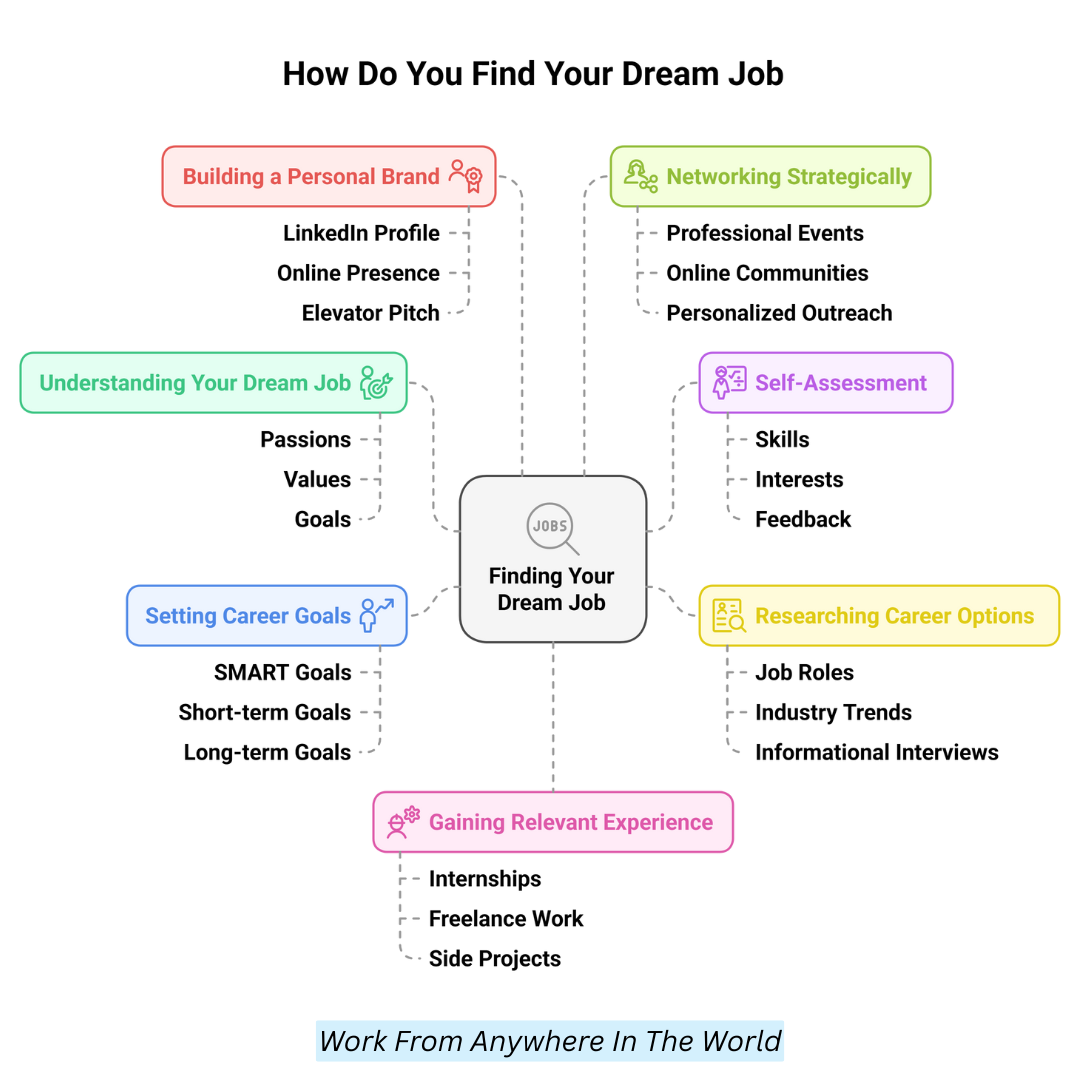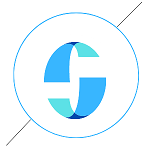How Do You Find Your Dream Job
How do you find your dream job? It’s a question that goes beyond salary and job titles. Your dream job aligns with your passions, values, skills, and lifestyle goals.
Whether you're just starting or seeking a career change, this guide will walk you through the key steps—from self-discovery to job interviews—to help you uncover and pursue the career that truly fulfills you.
Step-By-Step Guide On How To Discover And Get Your Dream Job
Finding your dream job doesn’t have to feel impossible. With the proper steps, clarity, and strategy, you can uncover a career that excites and fulfills you.
To assist you in finding your passion and transforming it into your ideal job, this guide breaks the process down into manageable, doable steps.
1. Understanding What A Dream Job Means To You
Begin by identifying what “dream job” means to you personally. This involves deep introspection about your passions, values, and long-term goals.
Think about the kind of work that excites you, the impact you want to make, and the lifestyle you envision. Create a list of must-haves and deal-breakers.
Consider journaling your thoughts, completing online assessments, and discussing your ideas with trusted mentors or friends.
This clarity will guide your career decisions and keep you aligned with what truly matters to you. Your dream job is the unique combination of what you love, what you’re good at, and what the world needs.
Key Points
- Reflect on passions, values, and goals
- Define your ideal lifestyle and impact
- List must-haves and deal-breakers
- Use journaling or self-assessments for clarity
2. Conducting A Self-Assessment
A self-assessment is essential for understanding your strengths, weaknesses, and preferences. Start by evaluating your hard and soft skills, your interests, and your core values.
Use tools like the Myers-Briggs Type Indicator (MBTI), CliftonStrengths, and the Holland Codes to gain structured insights. Reflect on past roles or experiences: What tasks energized you?
What environments drained you? Collect feedback from colleagues, mentors, and supervisors to identify patterns. This process helps you uncover where your talents and passions intersect and enables you to articulate your value proposition clearly when pursuing opportunities aligned with your ideal career path.
Key Points
- Identify strengths, weaknesses, and values
- Use MBTI, CliftonStrengths, or Holland Code
- Gather feedback from mentors
- Recognize patterns in past roles
3. Researching Career Options
With a better understanding of yourself, begin researching potential career paths. Use platforms like O*NET, LinkedIn, and Glassdoor to explore job roles, responsibilities, and salary expectations.
Look into the educational requirements, growth prospects, and industry trends. Identify companies whose missions align with your values—interview experts in areas that pique your interest for information.
These conversations provide valuable real-world insights beyond job descriptions. Create a shortlist of roles that resonate with your goals and skills.
This exploration phase helps narrow your focus, making your job search more targeted, efficient, and aligned with your long-term aspirations.
Key Points
- Explore roles on LinkedIn, O*NET, and Glassdoor
- Understand job duties, salaries, and growth
- Align job options with your values
- Conduct informational interviews
4. Setting Career Goals
Set clear, actionable goals to help you transition toward your dream job. Use the SMART framework: Specific, Measurable, Achievable, Relevant, and Time-bound.
Break your journey into manageable steps. For instance, short-term goals include completing a certification or revamping your resume.
Medium-term goals involve gaining experience in a related role. Long-term goals should focus on reaching your ideal position or organization.
To maintain accountability, write down your objectives and go over them frequently. Adjust as needed when priorities shift.
Goal setting turns your vision into a strategic plan and provides direction, structure, and motivation throughout your career journey.
Key Points
- Use SMART goals (Specific, Measurable, Achievable, Relevant, Time-bound)
- Break long-term goals into smaller tasks
- Track and adjust goals regularly
- Stay accountable and adaptable
5. Building A Personal Brand
Your brand is your professional reputation. Start by crafting a strong LinkedIn profile that highlights your achievements, skills, and goals.
Establish a constant online presence on websites such as your own or on social media sites like Medium and Twitter. Share insights, write articles, or showcase your work through portfolios or blogs.
Develop a concise elevator pitch that communicates who you are, what you do, and what you aspire to achieve. Be mindful of your online interactions and how they reflect your brand.
Having a strong personal brand makes you stand out in a crowded employment market, attracts opportunities, and fosters trust.
Key Points
- Create a strong LinkedIn and online presence
- Share insights and projects publicly
- Develop a clear elevator pitch
- Stay consistent with a professional image
6. Networking Strategically
Effective networking is about building meaningful, two-way relationships. Start by identifying who you want to connect with—peers, mentors, or industry leaders.
Attend professional events, webinars, and conferences to meet new people. Join online communities, forums, and LinkedIn groups.
When interacting, personalize your message and provide something of value, like a thought-provoking article. Follow up and nurture these connections over time. Ask for informational interviews rather than job favours.
The goal is to build a network that supports your career growth, provides guidance, and opens doors to opportunities often hidden from the public eye.
Key Points
- Connect with industry peers and mentors
- Attend events and join online communities
- Personalize outreach messages
- Maintain and nurture relationships
7. Gaining Relevant Experience
Experience is key to standing out, especially if you're switching careers. Start by seeking internships, freelance gigs, or volunteer opportunities in your target field.
Think about contributing to open-source platforms or working on side projects. Look for opportunities within your current job that align with your goals, like leading a new initiative or learning a new skill.
Document these experiences in a portfolio or resume. Real-world application of skills builds credibility and confidence. Even unpaid roles can add significant value and help you confirm whether a particular field or job is a good fit for your long-term vision.
Key Points
- Seek internships, freelance work, or volunteer roles
- Take on relevant projects at your current job
- Build and maintain a professional portfolio
- Use real-world experience to test fit

8. Upskilling And Lifelong Learning
Continual learning is essential in today’s fast-changing job market. Identify the skills required for your dream job and find relevant learning resources.
Sign up for online courses on sites such as Udemy, edX, or Coursera. Attend workshops, webinars, or bootcamps. Join professional associations and stay current with industry trends through blogs, podcasts, and newsletters.
Dedicate regular time each week to learning and improvement. Document your progress and apply new knowledge in real-life scenarios whenever possible.
Employers significantly admire your commitment to growth and adaptation, which is demonstrated by your lifelong learning in addition to improving your credentials.
Key Points
- Identify required skills and fill gaps
- Enroll in online courses and workshops
- Stay updated with trends through blogs and podcasts
- Practice and apply new skills consistently
9. Crafting A Winning Resume And Cover Letter
Your cover letter and CV are essential marketing documents. Tailor each document for the specific job you’re applying for. Highlight relevant achievements, quantifiable results, and keywords from the job description.
Keep formatting clean, concise, and professional. In your cover letter, go beyond your resume—tell a compelling story about why you're interested in the role and how you can contribute.
Avoid generic language; be specific and enthusiastic. Proofread carefully to avoid errors. A well-crafted resume and cover letter show that you understand the company’s needs and position yourself as the ideal candidate for the role.
Key Points
- Tailor each resume and cover letter
- Highlight achievements with data
- Match keywords from job postings
- Proofread and present professionally
10. Mastering The Job Interview
Job interviews require preparation and confidence. Start by researching the company’s history, mission, products, and culture. Use the STAR approach (Situation, Task, Action, Result) to prepare well-organized, persuasive answers to frequently asked questions. Practice with mock interviews or record yourself.
Pay attention to body language and maintain professionalism. To demonstrate your interest in the position and business, pose intelligent questions. Send a thank-you note afterward, reiterating your interest.
Every interview is an opportunity to learn; consider what worked and what could be improved. Authentic communication of your value, practice, and preparation is the key to mastery.
Key Points
- Research the company thoroughly
- Practice using the STAR method
- Ask insightful questions
- Send a follow-up thank-you note
Wealthy Affiliate – Mini Review (2025)
If you’ve ever thought about turning your blog, passion, or niche into an online business,
Wealthy Affiliate (WA) is one of the most beginner-friendly platforms I’ve used.
It combines step-by-step training, website hosting, SEO research tools,
and an active community all in one place.
What I like most: you can start free (no credit card needed),
explore lessons, test the tools, and connect with other entrepreneurs
before upgrading. WA isn’t a “get rich quick” scheme — it’s a platform where success comes
from consistent effort and applying what you learn.
11. Navigating Job Offers And Negotiation
Receiving a job offer is exciting, but take time to evaluate it carefully. Review the entire compensation package—salary, benefits, work-life balance, and career growth opportunities.
Compare it to industry standards and your personal needs. If it’s not ideal, prepare to negotiate. Use data to support your requests and communicate respectfully—practice negotiation conversations to build confidence.
Be open to compromise, and know your non-negotiables. If necessary, seek guidance from mentors or career coaches. Accept an offer only when it aligns with your goals and values. This process ensures you're not just landing a job but choosing the right one.
Key Points
- Evaluate total compensation, not just salary
- Use market data to support negotiations
- Be respectful and clear about expectations
- Accept only offers aligned with your goals
12. Embracing Flexibility And Resilience
The path to a dream job often includes setbacks. Stay resilient by embracing failures as learning opportunities. Reflect on what didn’t work and adjust your strategy.
Celebrate little victories along the way and have an optimistic outlook. Be open to unexpected paths or roles that may lead to better opportunities.
Adapt to changes in the job market and continue building skills. Take care of yourself and surround yourself with positive people.
Resilience and flexibility are critical traits that help you navigate the ups and downs of a career journey and keep moving forward despite challenges.
Key Points
- Learn from setbacks and adapt
- Celebrate small wins and stay positive
- Explore alternative paths when needed
- Maintain mental and emotional well-being
13. Leveraging Mentorship And Coaching
Mentors and coaches offer valuable guidance and accountability. Start by identifying individuals you admire in your field. Send them a sincere note indicating your desire to learn from them.
Be respectful of their time and clear about your goals. Schedule regular check-ins to discuss progress, challenges, and next steps.
A career coach can offer organized assistance and assist you in defining your goals, creating workable plans, and clarifying your vision.
These relationships provide encouragement, perspective, and insider knowledge, making your journey more strategic and less overwhelming.
Key Points
- Identify and approach potential mentors
- Be clear and respectful with time
- Use coaches for structured career planning
- Maintain regular communication
14. Aligning With Purpose And Passion
Your dream job should align with your deeper purpose and passions. Reflect regularly on whether your work excites and fulfills you.
Ask yourself:
- Am I learning?
- Am I contributing meaningfully?
- Does this job align with my values and long-term vision?
If the answer is no, consider making adjustments. Reassess your goals, explore new directions, and don’t be afraid to pivot.
You experience happiness, motivation, and a sense of fulfillment when your work is in line with your mission. Staying true to your passion ensures your career remains satisfying and sustainable over the long term.
Key Points
- Regularly reflect on your job satisfaction
- Ensure alignment with your values
- Be open to pivoting
- Choose purpose over paycheck when possible

These Tools Can Help You Find Your Dream Job
Several tools can help you find your dream job by making the process more efficient, organized, and targeted. Here’s a breakdown of useful tools and platforms that can help you at each stage of the job search:
Job Search Platforms
1. LinkedIn
LinkedIn is a strong networking site that does more than just serve as an online CV. You can connect with recruiters, follow companies, join industry groups, and apply to jobs while showcasing your skills, experience, certifications, and endorsements in one place.
2. Indeed
Indeed aggregates millions of job listings from around the web and lets you apply quickly using an uploaded resume. You can set up custom alerts, explore salary data, and filter jobs by location, experience level, industry, and employment type.
3. Glassdoor
Glassdoor provides company reviews from current and former employees, along with salary reports, interview questions, and benefits insights.
It’s perfect for learning what to expect before applying or interviewing, especially for evaluating company culture and transparency.
4. Google For Jobs
Google for Jobs compiles listings from multiple job boards and company sites, displaying them within your regular Google search.
It’s fast, intuitive, and lets you refine by title, location, experience, and company type without visiting separate platforms.
5. AngelList (Wellfound)
AngelList, now called Wellfound, is ideal for finding roles at tech startups. You can apply directly to founders, view upfront salary and equity offers, and search for remote-first or early-stage startup jobs in product, design, and engineering.
Resume & Cover Letter Tools
1. Zety / ResumeGenius / Novoresume
These platforms help you craft well-formatted, professional resumes and cover letters with modern templates. Their guided tools suggest content based on your experience, making the process faster, easier, and tailored to specific industries and job levels.
2. Jobscan
Jobscan compares your resume to a job description, showing how well it matches in terms of keywords and formatting. It improves your resume’s compatibility with Applicant Tracking Systems (ATS), increasing the chance of passing the initial digital screening.
3. Canva
Canva is excellent for creating unique, visually appealing resumes—ideal for roles in marketing, design, or media. Choose from stylish templates, drag-and-drop features, and personalize fonts, colours, and icons to make your resume stand out creatively.
Application Tracking Tools
1. Huntr
Huntr is a visual dashboard to track job applications, company contacts, deadlines, interviews, and notes. It helps you stay organized, avoid missed opportunities, and follow up effectively across multiple job listings during an active search.
2. Teal HQ
Teal offers an all-in-one job search workspace. You can track roles, tailor resumes to job descriptions, save notes, analyze job posts, and prepare for interviews—all from one tool designed to reduce job search stress and clutter.
Career Discovery & Skill Matching
1. CareerExplorer
CareerExplorer uses an in-depth personality and interests quiz to suggest potential careers. It also provides salary ranges, required education, and job satisfaction ratings—helping you better understand where your passions align with real-world career paths.
2. Myers-Briggs (MBTI) or 16Personalities
These tools assess your personality traits and work style preferences. Understanding your type helps you make career choices that align with how you think, communicate, and function in teams, leading to greater satisfaction and job alignment.
3. Skill Assessment Tools
LinkedIn, Coursera, and other platforms offer assessments to validate your expertise in key areas. High scores can be displayed on profiles or resumes, boosting employer confidence in your abilities and helping you stand out among other applicants.
Upskilling Platforms
1. Coursera / edX / Udemy
These platforms offer flexible, self-paced online courses from top universities and experts. You can earn certificates in areas like business, data science, or AI, enhancing your resume and making you more competitive in a changing job market.
2. LinkedIn Learning
LinkedIn Learning offers thousands of professional development courses across business, technology, and creative fields.
Completed courses are shown on your LinkedIn profile, demonstrating your commitment to learning and improving relevant job skills to potential employers.
3. Google Career Certificates
These are short, practical programs for high-demand fields like data analytics, IT support, and UX design. They’re affordable, require no degree, and come with job placement support from Google’s employer partners once you complete your certification.
Interview Preparation Tools
1. Big Interview
Big Interview combines video coaching and practice tools to help you improve your answers to behavioural and situational questions. You’ll learn to structure responses, build confidence, and succeed in both in-person and virtual interviews.
2. Interviewing.io
This platform offers mock technical interviews with real engineers from companies like Google or Facebook. Anonymous sessions let you practice coding and receive feedback in a realistic setting, helping you prepare for high-stakes job opportunities.
3. Prepfully
Prepfully connects you with mentors and professionals who’ve been through interviews at top companies. You can schedule mock interviews, receive personalized tips, and prepare for specific roles with insider insights about what to expect and say.

Conclusion
It's a journey rather than a destination to find your ideal employment. It requires reflection, action, and adaptability as your goals evolve. By following these steps, you’ll be better prepared to make informed choices and pursue meaningful opportunities.
So, how do you find your dream job? Start by understanding yourself, and take the next step with confidence. Your ideal career may be closer than you think.
I trust you enjoyed this article on How Do You Find Your Dream Job. Please stay tuned for more insightful blogs on affiliate marketing, online business, and working from anywhere in the world.
Take care!
— JeannetteZ
💬 Your Opinion Is Important To Me
Do you have thoughts, ideas, or questions? I’d love to hear from you. Please leave your comments below or email me directly at Jeannette@WorkFromAnywhereInTheWorld.com.
📚 More Work From Anywhere Reads
🚀 Ready to Build a Business You Can Run from Home
Or from Anywhere in the World?
Imagine creating income on your terms — from home, a cozy café, or wherever life takes you.
With the right tools, training, and community support, it’s entirely possible.
Start your own online business for free — no credit card needed.
Disclosure
This post may contain affiliate links. As an Amazon Associate and participant in other affiliate programs, I earn from qualifying purchases at no extra cost to you. Please read my full affiliate disclosure.






